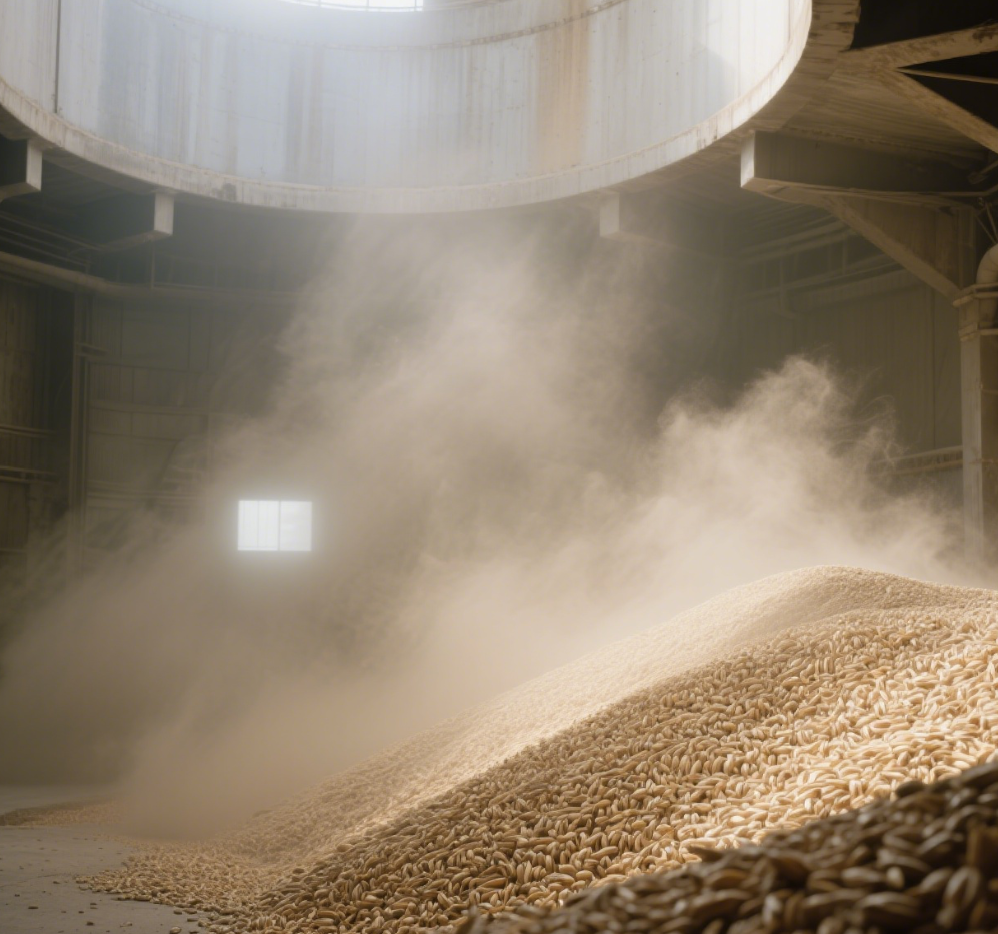1. Introduction
Grain storage silos are critical components in food supply chains and industrial bulk handling. However, these environments are often challenged by high dust concentrations, airborne particles, and constant material movement. Dust can interfere with conventional level measurement devices, causing inaccurate readings, frequent maintenance, and operational inefficiencies.
Traditional sensors such as floats, ultrasonic, and pressure-based devices often fail in dusty conditions. Airborne dust scatters or absorbs signals, resulting in fluctuating measurements or complete failure. Maintenance demands also increase because dust can accumulate on the sensor surface, further reducing reliability.
Linpowave millimeter-wave radar offers a robust solution to these challenges. By emitting high-frequency electromagnetic waves combined with advanced signal processing, these sensors provide reliable, non-contact level measurements. They can penetrate dust layers, reduce maintenance requirements, and ensure long-term operational stability.
2. Challenges of Dust Interference
2.1 Signal Attenuation and Scattering
Dust in grain silos consists of fine, suspended particles that create heterogeneous air layers. These particles interfere with conventional sensors in several ways:
-
Ultrasonic sensors: Sound waves are absorbed or scattered by dust, resulting in erratic readings.
-
Float sensors: Dust accumulation can obstruct mechanical movement, producing false readings.
-
Pressure sensors: Air pockets formed by dust may alter pressure measurements, leading to inaccurate level data.
High-frequency millimeter-wave radar, operating in the 76–81 GHz range, is less affected by dust scattering. Its short-wavelength electromagnetic waves penetrate airborne dust to reach the true surface of grain or bulk material, enabling stable measurement even in highly particulate-laden silos.
2.2 Dust Accumulation
Dust settling on conventional sensors can reduce accuracy and increase maintenance frequency. Contact sensors, in particular, require cleaning or recalibration more frequently in dusty silos. Non-contact millimeter-wave radar sensors avoid this problem entirely by mounting above the material surface, significantly reducing maintenance efforts.
3. Advantages of Millimeter-Wave Radar
3.1 High-Frequency Signal Penetration
Millimeter-wave radar emits short-wavelength electromagnetic signals capable of penetrating dense dust layers with minimal attenuation. This ensures that the radar can accurately detect the grain or bulk material level regardless of airborne dust concentrations.
3.2 Non-Contact Measurement
The sensor’s non-contact design avoids direct exposure to dust and moving material. This eliminates mechanical wear, prevents fouling, and allows for continuous, uninterrupted monitoring without cleaning.
3.3 Intelligent Signal Processing
Linpowave sensors integrate advanced algorithms to maintain measurement accuracy in dusty environments:
-
Echo filtering: Eliminates reflections caused by airborne dust particles.
-
Peak detection: Accurately identifies the true surface level of grain or bulk material.
-
Averaging and smoothing: Stabilizes readings even in turbulent or moving material conditions.
For further technical details, see Radar Level Sensors Overview.
4. Industrial Applications and Examples
4.1 Grain Storage Silos
Dust concentrations in grain silos can vary significantly depending on grain type, ventilation, and handling processes. Millimeter-wave radar sensors provide reliable level measurement, reduced maintenance, and seamless integration with SCADA systems.
Example: A wheat storage facility in Kansas installed Linpowave radar sensors in silos with high airborne dust levels. Even with frequent material movement and dust generation, the sensors maintained ±10 mm measurement accuracy over several months. Maintenance frequency dropped by 50% compared to previous ultrasonic sensors.
4.2 Industrial Bulk Material Storage
Chemical and feed silos often experience high dust levels during loading and unloading processes. Radar sensors excel in these scenarios by offering continuous monitoring without contact, maintaining stable readings, and reducing downtime.
Example: A feed processing plant implemented Linpowave radar in multiple silos. Dust storms and conveyor-induced turbulence did not affect measurement stability. The system enabled precise inventory tracking and minimized overflow risks.
5. Practical Recommendations
-
Sensor Placement: Mount the sensor centrally above the material surface, away from silo walls and discharge points to reduce reflections and turbulence interference.
-
Parameter Adjustment: Configure gain, threshold, and averaging settings according to dust concentration and grain type.
-
Periodic Inspection: Although non-contact, occasionally inspect the sensor housing for large dust accumulation.
-
Environmental Integration: Combine with dust concentration or airflow sensors to optimize measurement accuracy and receive early warnings.
6. FAQ: Millimeter-Wave Radar in Dusty Grain Silos
Q1: Can dust completely block radar signals?
A: Typical airborne dust does not block high-frequency radar signals. Algorithms filter out minor reflections, ensuring accurate measurements.
Q2: Does grain movement affect radar accuracy?
A: Non-contact sensors combined with averaging algorithms maintain stable readings despite turbulence and material flow.
Q3: How often should sensors be cleaned in dusty silos?
A: Minimal cleaning is required due to the non-contact design. Occasional inspection suffices for long-term stability.
Q4: Can radar sensors handle humid or slightly clumping dust?
A: Yes, intelligent signal processing allows effective measurement even when dust contains moisture or minor clumping.
7. Conclusion
Dusty grain silos present significant challenges for accurate level measurement. Linpowave millimeter-wave radar sensors overcome these challenges by:
-
Penetrating airborne dust with high-frequency signals
-
Employing non-contact measurement to avoid fouling and mechanical wear
-
Utilizing intelligent signal processing to ensure stable and reliable readings
Deploying these sensors ensures long-term, maintenance-free, accurate level monitoring, enhancing operational efficiency, safety, and automation capabilities.
Call to Action: Learn more about Linpowave millimeter-wave radar solutions for precise, reliable measurement in dusty silo environments.



